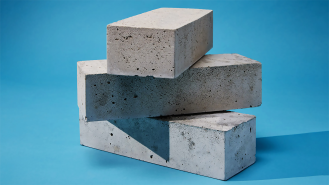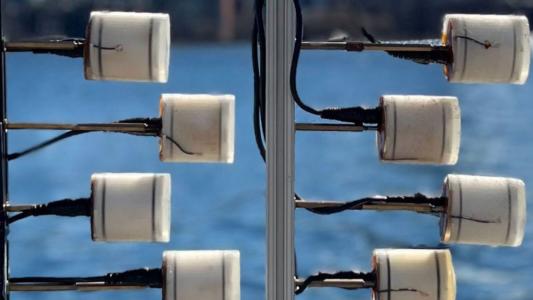A low-carbon cement developed by two MIT grads has officially exceeded industry standards for strength, durability, and more, clearing a major hurdle to commercialization.
The challenge: Cement is, quite literally, the foundation of global infrastructure. In 2022, 4.1 billion tonnes of the material went into the construction of buildings, highways, bridges, and more worldwide. That’s equivalent to the weight of 5,000 Golden Gate Bridges and about as much cement as the United States produced in the entire 20th century, in one year.
The cement industry is responsible for 8% of global CO2 emissions.
To make the most common kind, Portland cement, manufacturers bake limestone in kilns heated to around 2400 F. This separates limestone into carbon dioxide (CO2) and lime (calcium oxide), which is the ingredient needed for cement.
The CO2 is then mixed with the exhaust from the fossil fuels burned to heat the kilns. While it is theoretically possible to capture most of the CO2 in this mixture, it’s not easy or cheap, so the gas is typically just released into the atmosphere.
As a result, the cement industry is responsible for 8% of global CO2 emissions — that’s about three times as much as the aviation industry.
Low-carbon cement: Sublime Systems, a startup founded by two MIT grads, has developed a process that slashes the emissions generated during cement production.
Instead of using heat to extract lime from limestone, it uses a series of electro-chemical reactions — powered by electricity from renewables — at ambient temperatures to pull the cement ingredient from the rock.
Because the CO2 that remains is pure — that is, not diluted by other exhaust gasses — it’s easier to capture and store than the emissions from the traditional process.
Even better, Sublime’s technique can be used to separate lime out from other abundant calcium-bearing minerals. In those instances, it doesn’t generate any CO2.
Sublime Cement outperformed several other Portland cements in strength and durability.
What’s new? Sublime’s flagship product, Sublime Cement, has now received a C1157 designation from ASTM International, which means it meets agreed-upon industry performance standards.
According to Sublime, the material exceeded all benchmarks during testing and even outperformed several other Portland cements in strength and durability.
In many places, building codes forbid the use of cement that doesn’t meet ASTM standards, so this designation removes a major hurdle to integrating Sublime Cement into the construction industry.
“Passing the ASTM C1157 standard is an important milestone in showing that Sublime’s low-carbon cement innovation integrates into the same quality concrete building material that the construction industry requires,” said Leah Ellis, co-founder and CEO of Sublime.
“You won’t have an impact, no matter how wonderful your invention is, unless you’ve really sold it.”
Leah Ellis
Apples to apples: Sublime Cement might be more eco-friendly, but the standard kind currently costs less. To be competitive, the startup is going to need to significantly scale up production .
“When we are at full scale, we do expect that we will compete on cost with Portland cement,” Ellis told Carbon Herald. “We exclude any carbon capture credits, or fuel taxes, just apples-to-apples comparison. And then, of course, any carbon credits we can get will only improve the economics of our product.”
Looking ahead: Sublime is currently operating a pilot plant and expects to complete the first “field pours” of its low-carbon cement before the end of the year. The next step after that will be opening a commercial demonstration plant, which is currently scheduled for 2025.
“You won’t have an impact, no matter how wonderful your invention is, unless you’ve really sold it, and for cement, you have to sell it in very large volumes, so everything we do is about getting to a large volume and making sure the customers really like the product,” said Ellis.
We’d love to hear from you! If you have a comment about this article or if you have a tip for a future Freethink story, please email us at [email protected].






